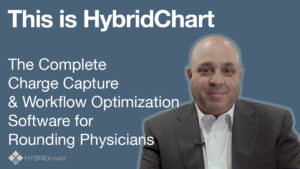Meet Dr. Sanders! He is our resident Cardiologist/HybridChart Creator who will be sharing his challenges as a physician, patient stories, trends in healthcare and more in our Disruptive Behavior series with Dr. Sanders. In this post, Dr. Sanders discusses MACRA and how HybridChart can help.
I think MACRA is on everyone’s mind right now.
Medicare released a final ruling and they made it clear that President-elect Donald Trump will not be overturning MACRA and that it is not going away. The final ruling on MACRA was a lot less intense. The ruling basically loosens the restrictions and requirements a little bit of in regards to what practices are going to have to do for reporting. Here are the other ways restrictions were loosened:
- in terms of time frame of when practices need to start reporting
- the number of items they need to report on
Essentially, the ruling gives a hall pass to practices that bring in below a certain threshold of Medicare revenue, or see less than a certain number of Medicare patients. This eliminates a huge chunk of medical practices in the country from having to report. I think everyone is probably breathing a little sigh of relief.
How HybridChart Can Help You With MACRA
It has become even more clear now how HybridChart can help you with MACRA. In regards to the way MACRA will work, the biggest thing I’ve identified is that they don’t want you to report on all your patients. They will choose a subset of your patients as “MACRA patients” that are representatives—a sample—of your Medicare population. Then you will just be measured on those patients.
Identifying MACRA patients just became extremely necessary and important. Due to the required reporting, the need to easily and visibly see you are treating a MACRA patient will be essential as providers will want to ensure that they are crossing ever ‘t’ and dotting every ‘I’ on these patients.
HybridChart could help when a patient is hospitalized—it can very quickly alert you that this is a MACRA patient because it’s tied into your whole system. There may be some separate data you are going to want to collect, but now that you know it is a MACRA patient, HybridChart can step in to help. Not only will HybridChart alert you, but it will help you to collect the appropriate data and easily report the data.
HybridChart provides you with the ability to create customized FLAGS and METRICS to establish streamlined processes and collect critical data. Flags are generally used to identify patients with specific traits, such as “Medicare Patient” or “Seen by Attending” – for the purpose of helping with decision making during the hospitalization. Flag information can also be used for data mining after discharge.
Similarly, Metrics are grouped into user-defined categories and can range from clinical data (ie, “Acute Coronary Syndrome”, or “On ACE Inhibitor”), to important information regarding discharge planning (ie, tests needed as outpatient, or “High Risk For Readmission”). The flexibility of both Flags and Metrics give practices virtually unlimited possibilities to capture relevant data. While one group may choose to identify patients on anticoagulation who will require monitoring, other clients may choose to label patients regarding eligibility for research trials. Any data points you create are easily searchable and reportable.
HybridChart eases the burden of MACRA. Sign up for a demo, we can help.
Still have questions about MACRA and all of the requirements that come with it? Join us Thursday, January 26th for our webinar, MACRA: Integrating Program into Practice.
{{cta(‘aa421dd2-82fe-40ff-87ba-f83c1f825f10’)}}








